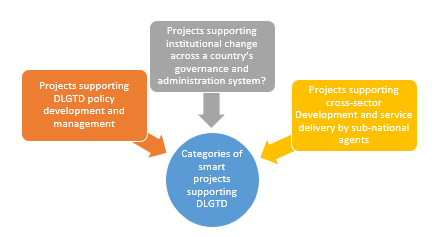5.3 Promoting DLGTD though smart projects
Supporting DLGTD is about facilitating policy and institutional changes that transform the sub-national system of governance and public administration and make it developmental. There are two types of orientation that can be taken:
-
Support to national DLGTD policy implementation (through budget support, standard projects…)
-
Support to national DLGTD policy development and innovation (through smart projects…)
Supporting a national DLGTD policy development and innovation from below means:
-
creating a “safe space” where innovative policy and institutional solutions could be locally experimented,
-
drawing lessons from an experimental work conducted through project modalities.
Lessons emerging from BS modalities could be combined with those emerging from project modalities to feed into a more realistic and more strategic policy dialogue and contribute to feasible and incremental policy reforms ‘from below’.
What are smart projects?
|
Smart projects offer a laboratory |
Smart project have a broader and more ambitious remit than standard project, they can help demonstrate that, given improved autonomy and accountability conditions, LAs can make a real difference in the country’s development. To achieve this goal, externally supported projects should seek to promote two types of partnerships between the various actors involved in DLGTD:

The scope of project aid to DLGTD
Project aid to DLGTD may be stand-alone projects; part of sector-wide programmes; or accompanying measures to budget support operations. They tend to fall into three broad categories:

The main ingredients of a smart project
The distinguishing feature of smart projects in support of DLGTD is that they are conceived as inclusive processes of policy and institutional experimentation typically carried out within one or several LA jurisdictions, and involving an often complex network of actors on, above and below the local level.
Experience shows three feature characterising successful smart projects:

|
To go further... read this
|
